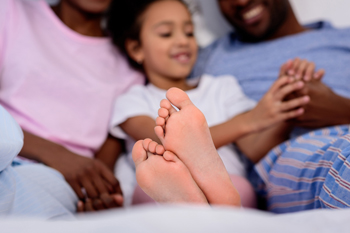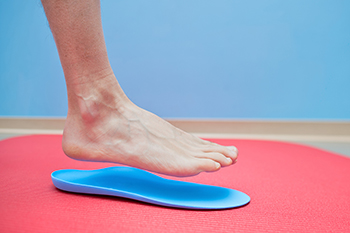Items filtered by date: January 2022
Which Foot Conditions Are Common in Children?
 Some foot conditions are not only experienced by adults but also by children. Foot conditions that are common in children include ingrown toenails, plantar warts, flat feet, and heel pain. Ingrown toenails occur when the edge of a toenail grows into the surrounding skin. This can cause pain and become infected when left untreated. Plantar warts are warts that grow on the bottom of the feet due to a viral infection. They typically appear as a circular area of thickened skin with black dots in the center and can be painful when pressure is applied to them. Flat feet are feet that have minimal or no arches in the middle of the sole of the foot. Flat feet typically don’t cause symptoms but may require treatment if your child complains of foot or leg pain or difficulty walking. Heel pain in children can have a variety of underlying causes, including plantar fasciitis and Sever’s disease. Sever’s disease typically occurs in the growth plate of the heel and affects children who are active and 8 to 14 years of age. If your child complains of any type of foot pain, it is recommended that you take them to a chiropodist for proper treatment.
Some foot conditions are not only experienced by adults but also by children. Foot conditions that are common in children include ingrown toenails, plantar warts, flat feet, and heel pain. Ingrown toenails occur when the edge of a toenail grows into the surrounding skin. This can cause pain and become infected when left untreated. Plantar warts are warts that grow on the bottom of the feet due to a viral infection. They typically appear as a circular area of thickened skin with black dots in the center and can be painful when pressure is applied to them. Flat feet are feet that have minimal or no arches in the middle of the sole of the foot. Flat feet typically don’t cause symptoms but may require treatment if your child complains of foot or leg pain or difficulty walking. Heel pain in children can have a variety of underlying causes, including plantar fasciitis and Sever’s disease. Sever’s disease typically occurs in the growth plate of the heel and affects children who are active and 8 to 14 years of age. If your child complains of any type of foot pain, it is recommended that you take them to a chiropodist for proper treatment.
If your child is experiencing foot or ankle pain, please consult with Chiropodist Stephanie Poupore from North Bay Foot & Ankle. Our clinician will assess your condition and provide you with quality foot and ankle treatment.
Common Causes of Foot Pain in Children
While children can experience many of the same foot problems as adults do, some foot problems may be more common during childhood.
Causes of foot pain in children can include:
Deformities that are present from birth, such as flat feet or clubfoot
Sever’s disease, which is an inflammation of the growth plate in the heel bone
Various sports injuries, such as sprains and fractures
Ingrown toenails
Athlete’s foot
Plantar warts
Prevention
It is important to look after the health of children’s feet in order to prevent future problems from arising. Keep your child’s feet clean and dry, trim their toenails regularly, ensure their shoes fit properly, and keep a watchful eye on any symptoms of foot pain, such as limping. If you notice any symptoms or if your child complains of foot pain, a chiropodist can help.
If you have any questions, please feel free to contact our office located in . We offer the newest diagnostic and treatment technologies for all your foot care needs.
Read more about Children’s Foot HealthPlantar Warts Can Be Treated!
Plantar Fasciitis and Orthotics
 Plantar fasciitis is a common overuse injury of the plantar fascia, a ligament that runs along the bottom of the foot. When the plantar fascia becomes inflamed, it produces symptoms such as heel pain, arch pain, and difficulty walking. Orthotics are often prescribed to treat plantar fasciitis. Your chiropodist may suggest heel cups or pads. These are inserts placed directly under the heel to cushion it, absorb shock, and reduce tension on the plantar fascia. You may also be prescribed shoe insoles. These are either half the length of your entire foot or full length and support the arch, correct biomechanical problems, and reduce pressure on the plantar fascia. To learn more about orthotics and see if they may be right for you, please consult with a chiropodist.
Plantar fasciitis is a common overuse injury of the plantar fascia, a ligament that runs along the bottom of the foot. When the plantar fascia becomes inflamed, it produces symptoms such as heel pain, arch pain, and difficulty walking. Orthotics are often prescribed to treat plantar fasciitis. Your chiropodist may suggest heel cups or pads. These are inserts placed directly under the heel to cushion it, absorb shock, and reduce tension on the plantar fascia. You may also be prescribed shoe insoles. These are either half the length of your entire foot or full length and support the arch, correct biomechanical problems, and reduce pressure on the plantar fascia. To learn more about orthotics and see if they may be right for you, please consult with a chiropodist.
Orthotics are devices that are typically inserted into shoes to treat a variety of foot and ankle problems. If you would like to learn more, please consult with Chiropodist Stephanie Poupore from North Bay Foot & Ankle. Our clinician can help you maintain the health of your lower limbs and your mobility.
What Are Orthotics Used For?
Orthotics are used for the treatment of a variety of foot and ankle problems. These can include biomechanical issues, gait abnormalities, foot pain, injuries, arthritis, deformities, and other medical conditions that affect the lower limbs. Orthotics can be bought in a store or custom-made and prescribed by a chiropodist.
Types of Orthotics
Rigid - Made from carbon fiber or other hard material and designed to ease foot pain and strain
Soft - Made from flexible materials like foam and designed to cushion and support the foot
Full shoe inserts
Half shoe inserts
Heel cups
Heel pads
Night splints
Braces
And more
If you have any questions, please feel free to contact our office located in . We offer the newest diagnostic and treatment technologies for all your foot care needs.
Read more about OrthoticsAvoiding Overuse Injuries From Running
 While winter may have kept runners away from roads and trails due to snow, ice, and the cold, spring’s warmer weather draws many runners out of hibernation. Unfortunately, a sudden increase in physical activity can also come with a sudden increase in the risk of incurring various foot and ankle injuries. Repetitive strain and overuse are one of the leading causes of injury among runners. Fortunately, these problems can be prevented by planning ahead. When beginning to run again after a long period of rest, start slowly and increase the duration, length, or intensity of your runs gradually over time. Take days off to give yourself time to recover following runs. Recognize and treat any foot or ankle pain as soon as it arises. For more information, please consult with a chiropodist.
While winter may have kept runners away from roads and trails due to snow, ice, and the cold, spring’s warmer weather draws many runners out of hibernation. Unfortunately, a sudden increase in physical activity can also come with a sudden increase in the risk of incurring various foot and ankle injuries. Repetitive strain and overuse are one of the leading causes of injury among runners. Fortunately, these problems can be prevented by planning ahead. When beginning to run again after a long period of rest, start slowly and increase the duration, length, or intensity of your runs gradually over time. Take days off to give yourself time to recover following runs. Recognize and treat any foot or ankle pain as soon as it arises. For more information, please consult with a chiropodist.
Springtime is the season that many people use to get back into exercising and sports. It’s also a time when foot and ankle injuries may be more common. If you have a foot or ankle injury, please consult with Chiropodist Stephanie Poupore from North Bay Foot & Ankle. Our clinician can help you maintain the health of your lower limbs and your mobility.
Common Foot and Ankle Problems in Spring
Plantar fasciitis
Achilles tendonitis
Shin splints
Strains
Sprains
Fractures
And more
Avoiding Injury
Increase physical activity slowly and gradually
Wear comfortable, well-fitted shoes and socks
Take time to rest following a workout
Recognize and treat any injuries promptly
Treatment at Home
Rest the injured foot
Apply ice to reduce swelling
Compress the injured foot with a bandage
Elevate the foot to prevent swelling
Serious, chronic, or particularly painful injuries require medical care by a professional. If you have any questions, please feel free to contact our office located in . We offer the newest diagnostic and treatment technologies for all your foot care needs.
Read more about SpringWhat Should I Do if I Have a Foot Blister?
 Blisters are small, fluid-filled bumps that typically develop on the feet due to friction. They usually heal on their own given time. It is best not to pop a blister, as the fluid inside protects the raw skin underneath the blister from the environment. If you find yourself with a foot blister that is likely to burst on its own, it is recommended that you cover it with a bandage or soft dressing to protect it. If your blister has burst, wash your hands before touching the area and allow the blister to fully drain before covering it with a bandage. If you have a foot blister that is showing signs of infection, such as redness, warmth, pain, swelling, or the appearance of pus, it is strongly suggested that you seek treatment from a chiropodist.
Blisters are small, fluid-filled bumps that typically develop on the feet due to friction. They usually heal on their own given time. It is best not to pop a blister, as the fluid inside protects the raw skin underneath the blister from the environment. If you find yourself with a foot blister that is likely to burst on its own, it is recommended that you cover it with a bandage or soft dressing to protect it. If your blister has burst, wash your hands before touching the area and allow the blister to fully drain before covering it with a bandage. If you have a foot blister that is showing signs of infection, such as redness, warmth, pain, swelling, or the appearance of pus, it is strongly suggested that you seek treatment from a chiropodist.
Blisters can usually be treated at home, however, if you have recurring blisters or experience significant discomfort or pain, please consult with Chiropodist Stephanie Poupore from North Bay Foot & Ankle. Our clinician will assess your condition and provide you with quality foot and ankle treatment.
What Is a Blister?
A blister is a small pocket of fluid in the upper skin layers and is one of the body’s natural responses to injury or pressure. Blisters can also result from burns, fungal or viral skin infections, and the feet are particularly prone due to ill-fitting footwear and friction. Friction on the skin causes the upper layer of skin to separate from the lower layers. The space that this separation creates then becomes filled with a liquid called serum, which protects the lower layers of skin.
Treatment
If you notice a blister on your foot, you can cover it with a soft bandage or dressing to protect it. Popping the blister is discouraged. Doing so exposes the raw skin underneath it to bacteria and also raises the risk of infection. If a blister pops naturally, let it drain before covering it with a bandage. Blisters usually heal on their own or with home treatment, however, if your blister is recurring, very painful, or appears infected, it is recommended that you see a chiropodist for treatment.
Prevention
You can help to prevent blisters by wearing comfortable, well-fitted shoes. Keep your feet dry by wearing moisture-wicking socks and dust your feet with talcum powder if they tend to get sweaty. If you have areas on your feet that are more susceptible to blisters, you might be able to prevent the blister from forming by covering it with a pad.
If you have any questions, please feel free to contact our office located in . We offer the newest diagnostic and treatment technologies for all your foot care needs.
Read more about Blisters
